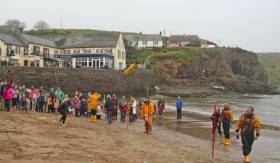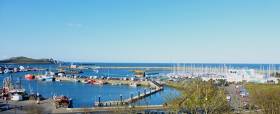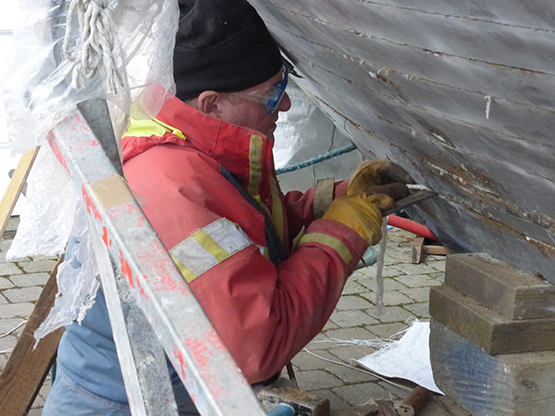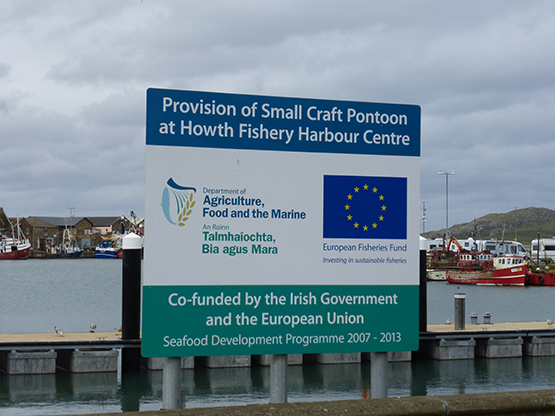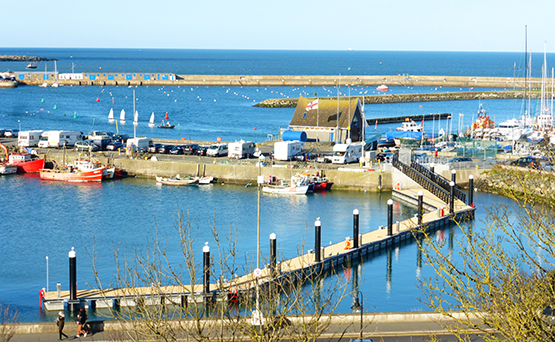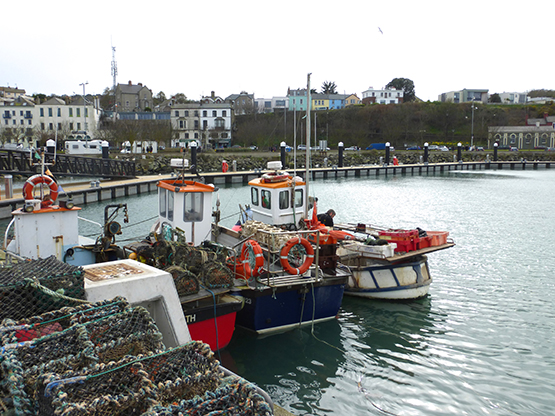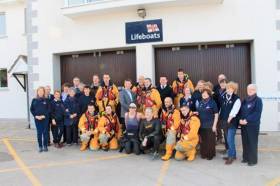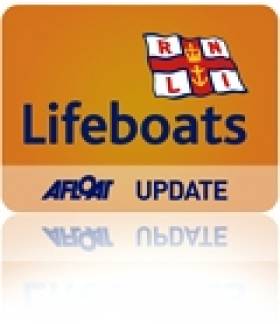Displaying items by tag: Dunmore East
Dunmore East RNLI Raises Vital Mayday Funds
#RNLI - Vital funds have been raised for the RNLI following the annual Dunmore East lifeboat 'Dash & Splash' and yellow welly throwing competition.
The event, which took place at Councillor’s Strand in Dunmore East on Sunday 1 May, was run as part of Mayday, the RNLI’s national annual fundraising campaign.
Dunmore East RNLI fundraising branch volunteer Carol McGeary said: "I’d like to thank everyone who came and supported the Dash & Splash and yellow welly throwing competition.
"We were especially delighted to have Senator Grace O’ Sullivan taking part and leading the swimmers into the water.
"We all had great fun with the welly throwing competition and the crew even challenged our supporters to a beach soccer match. The funds raised will help the RNLI continue to save lives at sea’.
McGeary added that RNLI volunteers in Dunmore East and around Ireland "are willing to drop everything to go and save lives at sea when their pagers beep.
"Mayday is the RNLI’s own call for help, as we rely on the generosity of the public to continue our lifesaving service, which we operate day and night, 365 days a year."
Many of the Mayday fundraising events that have taken place across the country have had a yellow welly theme, in a nod to the essential kit that the RNLI’s lifeboat crew members wear on their feet when they go out to sea to save lives.
Money raised through the Mayday campaign – which ran from Tuesday 26 April to Monday 2 May – will support the RNLI’s lifesaving work. It could be used to fund crew training, contribute towards the running costs of a lifeboat station or buy new crew kit like the yellow wellies.
There is still time to support Mayday. Visit RNLI.org/Mayday to donate.
The RNLI operates 45 lifeboat stations around Ireland. Last year, RNLI lifeboat crews in Ireland launched 1,098 times bringing 1,244 people to safety.
Howth Harbour Thoughts From Home
This weekend has the Irish Sailing Youth Pathway Championships being staged at Howth, and despite the weather the place is buzzing. From being a harbour abandoned in embarrassment for twenty years in the middle of the 19th Century, the peninsula port has gradually evolved to develop a vibrant balance between fishing harbour, sailing centre, and visitor magnet. Longtime local W M Nixon tries to tell it like it is in Howth when seen from the inside.
Howth has most of the advantages and few enough of the disadvantages of being an island. Head home eastward through the isthmus at Sutton Cross (and don’t forget you’re heading eastward - Howth is Dublin’s Eastside, while the Northside is in nearby Ireland), and you shed your Irish identity to become a Howth person. Ideally, this means you become a complete nobody among many other nobodies, for that’s the way we like it.
It must be some sort of defence mechanism, for there was a period in the middle of the 1800s when the powers that be in nearby Ireland preferred to forget our very existence. You see, when the vital links of government between Dublin and London were being maintained by special sailing packet ships, Howth was important because the island of Ireland’s Eye (even in this blog we haven’t the space to explain how it got its name), which is upwards of half a mile off the distinctly rough village, was able to provide an element of natural shelter at a time when Dublin Bay and Dublin Port tended frequently to be disaster areas for shipping.
There were times when the only shelter in Dublin Bay itself was in the very limited space inside Dalkey Island, where a sailing ship could easily be trapped, whereas Howth Sound inside Ireland’s Eye, while north of Dublin Bay and beyond the Baily, nevertheless enabled a potentially embayed ship to cut and run. And yes, that is how the phrase originated.
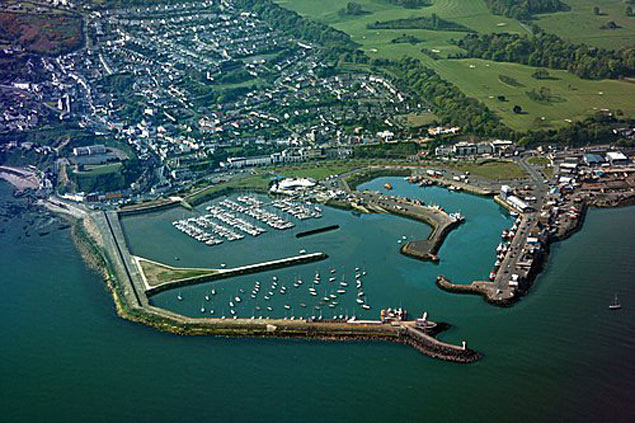
The north side of Dublin Bay in 1692. The Government’s cross-channel packet boats favoured the roadstead anchorage at Howth inside Ireland’s Eye as it provided better shelter than the exposed bay itself, yet there was more space to cut and run than could be found in Dalkey Sound
Thus they built an inn in the village so that people passing through to London, and waiting for the packet boat, would not impose unduly on the hospitality at Howth Castle of the St Lawrence family, unless they were awfully important. And then when the engineer Thomas Telford was commissioned to build a road linking London with Dublin through Holyhead, naturally on the Irish side he followed the official view of things and continued his road through Howth and on towards Dublin, in light of the fact that offical policy was that the Government harbour would be built at Howth.
And build it they did, from about 1807 onwards, with John Rennie in charge. But with the gathering prosperity and increased trade after the final end of the Napoleonic Wars in 1815, the movement for the improvement of Dublin port and the building of an “asylum harbour” at Dunleary within Dublin Bay gained traction, and by 1817 what would soon become the highly-fashionable Kingstown Harbour was already under construction before Howth Harbour was even properly finished.
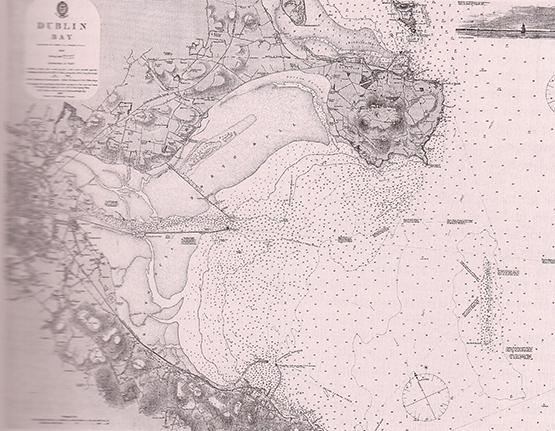
Once the new harbour had been completed at Dunleary on the south side of Dublin Bay and re-named Kingstown, the smaller shallower harbour at Howth was forgotten about for twenty years
Nevertheless Howth continued as the official mailboat port until 1834, by which time even the most stubborn official mind had to recognise that everyone else had long since gone Southside. So at last the powers that be followed. And in doing so, they tacitly agreed that the best way to deal with the memory of the ENORMOUS expenditure of building shallow sandy Howth Harbour was to ignore the place’s very existence for as long as possible.
The local fishermen continued to use the sandy creek of Balydoyle as their main port as they’d always done, while Howth seems to have been out of bounds to just about everyone. It was declared an inviolate Royal Harbour which might be of strategic value in the event of attack by Barbary pirates or Eskimo marine commando units or whatever, and for maybe fifteen years Howth simply slumbered, quietly silting up.
But by the 1850s, the growth of the fishing industry through travelling fleets of trawlers from the great fishing ports of Devon and Cornwall and Scotland and the east coast of England meant that increasing numbers of high-powered fishing skippers, almost entirely from Britain, were demanding that they be allowed to use Howth, and by the 1860s it had been designated a “Fishing Station”.
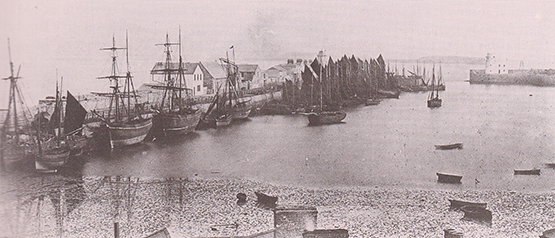
Howth Harbour in the 1870s, when it had become a “Fishing Station”
Much the same thing happened at Dunmore East, which was initially the packet boat port for Waterford, and the local fishermen weren’t really allowed into it at all. But then the advent of steamships meant the packet boats could go straight up to Waterford itself, and after an interval lying idle, Dunmore East also became a Fishing Station. But it was only because nobody else further up the pecking order had a use for it – in those days, fishermen were expected to fend for themselves.
So for thirty years and more, Howth was almost totally devoted to fishing, but in 1875 the famous Judge Boyd – he is referenced in Ulysses – took a lease on the harbourside Howth House which had originally been built as a residence for John Rennie, the engineer building the harbour. The Judge was well got, as his main house was in Merrion Square – it’s now the French Embassy – but as he was something of a maverick, he decided that he’d pursue his sport of sailing through Howth rather than Kingstown.
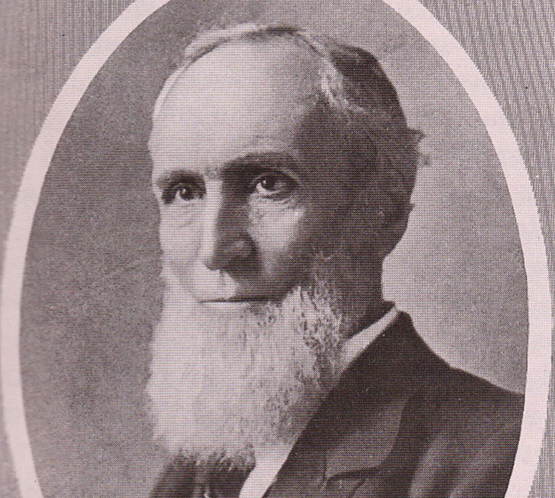
Judge Boyd was such a noted Dublin character that he was referenced in Joyce’s Ulysses
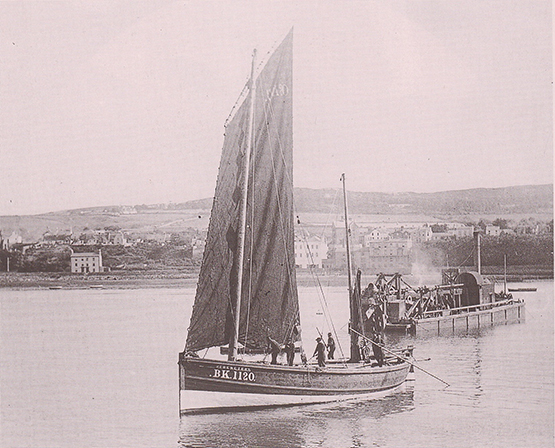
Thanks to Judge Boyd’s influence, Howth had a government dredger almost permanently on station from 1888 onwards. And for those who would seek further cultural references, the Yeats family lived in the house on the foreshore just to the left of the fishing boat from 1880 to 1882
A maverick he may have been, but he had influence in high places, and when the silting of Howth became even worse in the 1880s, hampering the seasonal activities of the travelling fishing fleets, the Judge saw to it that Howth got its own government dredger as an almost permanent feature.
The trouble is, the fishing was too successful – the herring were fished almost to extinction. By the 1890s, fleets visiting Howth were declining rapidly, but this in turn facilitated the development of the local sailing club, founded mostly by Judge Boyd’s sons in 1895.
However, the old Judge had lost none of his sparkle, for in 1892 he had bought the supposedly out-classed Fife 70-footer Thalia from the Clyde, and proceeded to win races left right and centre with her. Often he helmed her himself, but if he felt like a rest, the talented professional skipper who came with the boat was Owen Bissett, who stayed on in Ireland with such commitment that today one of Howth’s most able sailors, Ross McDonald, is Owen Bissett’s great-great grandson.
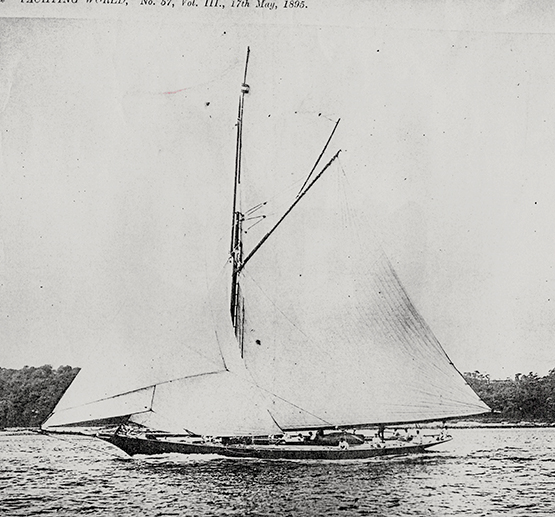
Judge Boyd’s Thalia racing in the Clyde – in Clyde Fortnight 1897 she won 140 pounds in prize money, the third highest in the regatta. Though he raced the boat himself, Judge Boyd also had a professional skipper in Owen Bissett, great great grandfather of today’s successful Howth skipper Ross McDonald
And if you wonder how the Judge managed to keep a large engineless yacht in little Howth Harbour, a yacht whose overall length from mainboom end to bowsprit end was well over a hundred feet, the answer is he treated Howth Harbour as if it was his private marina. After all, it was he who ensured it was dredged, so hadn’t he every right to keep Thalia in a very handy berth inside the nib on the West Pier? And if he happened to omit to retract Thalia’s long bowsprit which protruded well beyond the end of the nib, then heaven help any fishing skipper whose ancient craft managed to get fouled up in this exquisite piece of classic yacht equipment.
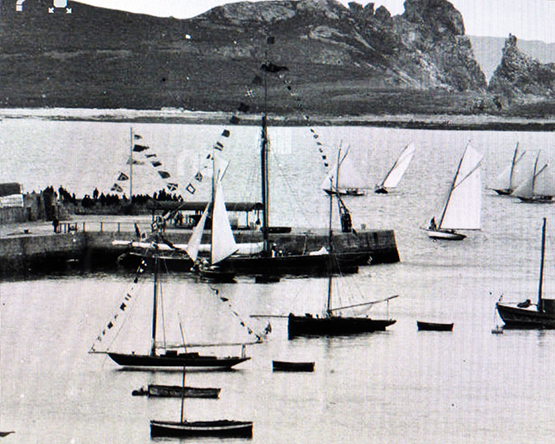
Regatta day at Howth, and Thalia in her berth inside the nib on the West Pier
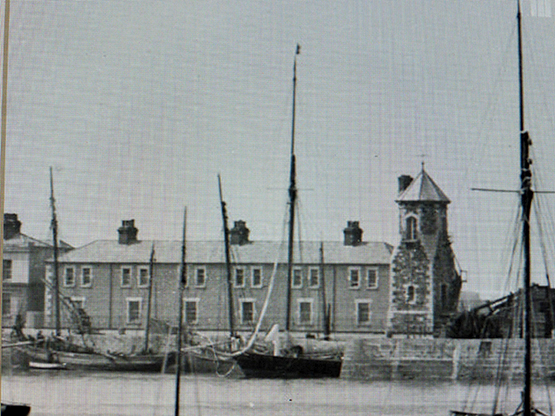
The perfect private berth – Thalia at the West Pier in Howth around 1900
It’s difficult to escape the feeling that the Judge’s four sons thought the old man was maybe a bit over the top, for in their new Howth Sailing Club they promoted the notion that “Small is Beautiful”. When the oldest brother Herbert designed the new one design class for Howth in the Autumn of 1897, the resulting Howth 17s were of very modest proportions, just 22ft 6ins in overall length.
In time, the mighty Thalia ceased to be a feature of Howth Harbour. She was of such a size that the easiest way to lay her up was a winter berth afloat in the Grand Canal basin in Dublin. But as she had been built on steel frames with copper fastenings, she was virtually on fire with electrolysis, and her days were short – by 1910 she had gone.
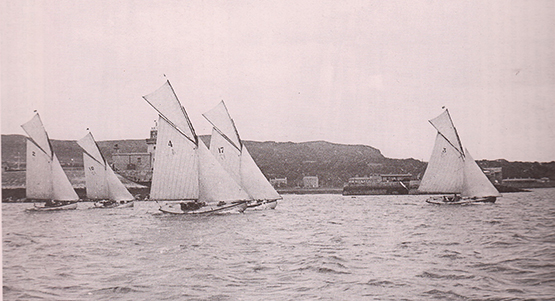
A much more modest proposition – the handy little Howth 17s were introduced in 1898, and they hope to have 18 boats racing this summer
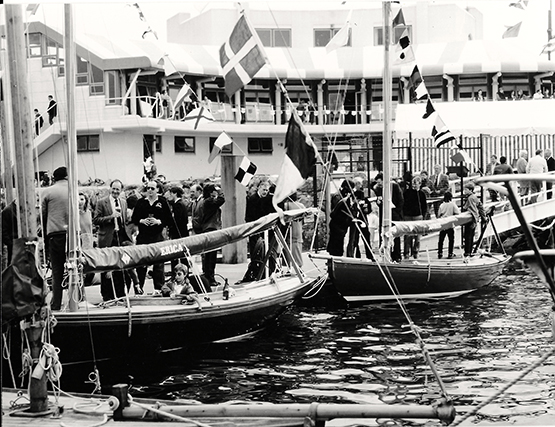
From time to time, the Howth 17s add new boats – this is Erica and Isobel joining the fleet in 1988
The joys of classic yacht ownership…..Pat Heydon working in early March on the re-caulking of Gladys (built 1907), which he co-owns with Eddie Ferris and Ian Byrne. Photo: W M Nixon
But the Howth 17s plough steadily on 118 years later, thanks to a sort of group scheme of mutual help when a boat needs serious work done, with longtime owner Ian Malcolm as the multi-talented core of a sort of men and women’s shed movement with a maritime purpose. The purpose is to get in as much racing as they can, with as many boats as humanly possible. This season they’ll have 18 of them sailing, while a classic boat festival at Howth in early August has already roped in Mermaid Week, and they and the Seventeens will be more than happy to welcome other long-established wooden craft.
As for Howth generally, the inevitable conflict between the needs of fishing craft and the needs of recreational boating were more or less resolved back in 1982, when the recreationals were moved into the eastern part of the harbour with its marina and - in time - a completely new clubhouse, while the western section became a state-of-the-art fish dock with synchro-lift and all the trimmings.
It was a case of good fences making good neighbours, and maybe the harbour users of Howth became too contented, for the powers-that-be seemed to forget that in a harbour set beside a sandy channel through which the tide can flow with some vigour, routine maintenance includes regular dredging.
In The Netherlands, arguably the best-run maritime nation in the world, every harbour is dredged as a matter of routine every four to five years, regardless of whether or not there has been significant silting. It’s just done, and that’s how it is – it’s the Dutch way.
But in Ireland, it seems we have to chivvy the authorities to do what should be a matter of routine, and ultimately it all seems to come back to the door of the Office of Public Works, which despite its name seems to think that it’s activities should be carried out in as private a way as possible. Maybe it should be re-named the Office of Good Works By Stealth, for the word is that Howth is going to be dredged, and it might well be sooner than later.
Meanwhile, the Department of Agriculture & Fisheries have been quietly beavering away providing the small boat fishermen with their own rather splendid pontoon. It’s an extremely fine bit of work, but so far as we know, it is only recently that the notice has gone up telling us what it’s all about.
It’s coming to a harbour near you…….the notice of the new facility was erected without any fanfare...
...and for the time being there’s no news of when the new pontoon will be officially opened
As for actually getting the use of it, the situation is now a bit reminiscent of the 1840s. There’s this really classy and useful bit of infrastructure, just as there was once the unused Howth Harbour back in the 1840s. But nobody is as yet allowed near it. The smaller fishing craft still raft up outside each other, and their crews still have to clamber up the quayside.
There’s probably a perfectly good reason why the new pontoon has not yet opened for business. But as our email enquiry to the Department has gone unanswered, we can only assume that until a new Government is formed and there’s a fully-accredited new Minister ready to sweep out in the limo to perform the opening ceremony with all the attendant pomp and kudos, then this lovely pontoon will continue to float serenely on, just like the Sleeping Beauty.
While Howth’s new small fishing craft pontoon awaits its official opening, its future users continue to raft up alongside each other at the quay. Photo: W M Nixon
#OpenWaterSwim - The first ever Dunmore East RNLI Open Water Swim was launched with great fanfare yesterday (Thursday 10 March) by well-known hotelier John Brennan.
A very keen sailor who's hosted boating events at his Dromquinna Manor in Kenmore, Brennan visited the lifeboat station to officially launch the swim and to give his support to the work of the RNLI.
Brennan also runs the famous Park Hotel along with his brother Francis, and the two presented the popular TV show At Your Service together for a number of years.
He has huge interest in all things maritime, and his son Adam has recently graduated as a Super Yacht Master on the Isle of Wight. All of this made him the perfect choice for the launch.
The swim will take place on Sunday 29 May, with the first swim starting at noon. The three swims will be over distances of 500m, 750m and 1500m.
As the demand for and interest in different sporting events increases, the fundraising branch of Dunmore East were keen to host a major event that would see people take part in a rewarding and challenging open water swim.
Speaking at the launch, Dunmore East RNLI crew member Neville Murphy said: "We had the idea for this swim for quite a while before we took the plunge and went for it.
"We live in one of the most beautiful parts of the country with a stunning coastline and it is the perfect location for this type of event. We hope that for this our first year, we generate lots of interest and entries, which in turn will help us raise funds for the RNLI and their lifesaving work."
Murphy added: "We are very grateful to John Brennan who made the long journey from his home in Kerry to launch our event. Many people know him for his hospitality work, but he is also a very keen sailor and he knows the importance of people being able to swim when you live on our coastline."
Throwing his support behind the event, Brennan said: "As I know personally, it can be quite challenging to get a new venture off the ground. I hope people will get behind it and raise funds for the RNLI, which is a great charity and one close to my heart as a sailor."
Following the launch, Brennan kindly donated a voucher for two nights B&B and dinner in his luxurious five-star Park Hotel in Kenmare.
The event committee has decided to hold a random draw on the day which will include all event participants and the selected winner will receive the voucher as a prize. All prizegiving will take place in Waterford Harbour Sailing Club after the completion of all three swims.
For more information about the Dunmore East RNLI Open Water Swim and to register online go to www.athleticstiming.com. Entry costs €25.
Dunmore East Lifeboat Rescues Five On Trawler With Engine Failure
#RNLI - Dunmore East RNLI launched on Friday (8 January) to assist a 50ft fishing vessel with five people on board.
The vessel suffered engine failure eight miles from Dunmore East Harbour.
Just before 5pm the volunteer lifeboat crew at Dunmore East RNLI launched their all-weather lifeboat at the request of the Irish Coast.
Some 15 minutes later, the Trent Class lifeboat Elizabeth and Ronald arrived on scene and the casualty vessel was then towed into the safety of Dunmore East Harbour, just after 7pm.
Speaking following the callout, Dunmore East RNLI coxswain Paulie Daniels said: "Our crew responded very quickly to the pagers and thankfully it turned out to be a very straight forward tow.
"Conditions were tough with rain throughout and wind and sea freshening."
Coveney Inspects Progress On €6m Dredging Works At Dunmore East Fishery Harbour Centre
During his visit to the South East, The Minister for Agriculture, Food and the Marine, Simon Coveney TD, took the opportunity to inspect progress on the €6m dredging works at Dunmore East Fishery Harbour Centre. The works which involve removing approx 27,000 metres cubed of material located in the harbour basin and in the approach channel to the port, commenced in June and are substantially completed.
The Minister said “I am delighted to hear that the dredging project in Dunmore East is progressing according to plan and within budget. When completed it will transform the harbour for all our users and play an important part in increasing economic activity and creating much needed jobs here in the South East.”
The material in the harbour basin which was heavily contaminated has now been successfully dredged, treated and removed from the harbour, work is set to commence on removing approximately 6000 metres cubed of material from the entrance channel which is not contaminated. It is expected that the works will be fully completed by the end of November.
The Minister went on to say “These works will remove the operational difficulties experienced by fishermen, landing times and vessel management will be much improved as will the availability of the syncrolift, which is required to raise vessels to facilitate their repair and maintenance. Marine leisure users will also see benefits and overall the harbour will be more attractive operationally for the increasing cruise liner traffic.”
The Minister concluded saying “These much needed works are a sign of my Governments commitment to the South East and complement other recent investments in Dunmore East on the new and enlarged slipway for marine leisure and fisheries users and also the newly opened harbour user’s facilities in the ground floor of the Harbour Management Building.”
As part of his visit to the South East today, Minister Coveney met with local fishing industry in Kilmore Quay to discuss the introduction of the first phase of the new landing obligation or ‘discards ban’ for the whitefish fleet.
Minister Coveney said “Today was an opportunity for me to outline what has been agreed in terms of the phasing in of the landing obligation under the new Common Fisheries Policy for our whitefish fleets. Just as importantly, it was an opportunity for me to listen to the concerns of our fishing industry with regard to this major change in the way our fleets will operate in the future.”
Dunmore East Lifeboat Launches To Grounded Yacht
#RNLI - The volunteer lifeboat crew with Dunmore East RNLI launched on Tuesday morning (22 September) following reports that a 10m yacht was aground two miles north of Hook Head.
Fethard RNLI and Waterford's Irish Coast Guard helicopter Rescue 117 were also called out to the scene, where the Dunmore East lifeboat crew saw that the vessel was sitting deep in the water and was perilously close to the rocks.
There was nobody on board the yacht, which may have drifted after coming free of its moorings.
First on scene was the Fethard RNLI inshore lifeboat, whose crew established a tow with the yacht. However this proved unsuccessful.
Shortly after, Dunmore East arrived and put two crew on board the casualty vessel with a pump to try and drain the water from the yacht and establish another tow to recover it to a nearby harbour.
But once on board, the lifeboat crew discovered that the yacht had taken on a large amount of water and that it was in danger of sinking. When they attempted to establish a tow the vessel dangerously dipped low into the water and the attempt was abandoned.
The decision was then made to leave the vessel as it was determined that the crew were in danger if they stayed on the yacht.
Commenting on the callout, Dunmore East RNLI lifeboat press officer and crew member Neville Murphy said: "The yacht had taken on a huge amount of water and as such it proved too difficult to safely recover her.
"Once it was established that there was no threat to life and it was clear it was too dangerous to safely recover the vessel we made the right decision to step away.’
Las of late in Tuesday the vessel was still aground, but an attempt may be made to recover her at low water.
Unmanned Yacht Aground off Hook Head
A 10–metre catamaran type yacht that ran aground two miles north of Hook Head, in County Wexford, Ireland is believed to have drifted free from its moorings.
Volunteer lifeboat crew launched yesterday morning following reports of the grounded cruiser. On arrival, the lifeboat crew found the unmanned yacht sitting deep in the water, perilously close to the rocks.
First on scene was Fethard RNLI Inshore lifeboat whose crew established a tow with the yacht, however this proved unsuccessful.
Shortly after, Dunmore East RNLI Lifeboat arrived on scene and put two crew on board the casualty vessel with a pump to try and drain the water from the yacht and establish a tow to recover it to a nearby harbour.
However, once on board, the lifeboat crew discovered that the yacht had taken on a large amount of water and that it was in danger of sinking. When they attempted to establish a tow the vessel dangerously dipped low into the water and the attempt was abandoned.
The Irish Coast Guard Rescue Helicopter Rescue 117 were also called out to the incident.
A decision was taken to leave the vessel as it was determined that the crew were in danger if they stayed on the yacht.
Successful Defence of the Fireball Nationals Title
#fireball – Barry McCartin & Conor Kinsella (15114) put together an almost flawless defence of their 2014 Irish Fireball Nationals title in Dunmore East over this past weekend writes Cormac Bradley. Almost flawless? They dropped one race in the nine-race event, finishing second in Race 7, but winning all other races.
International Race Officer Con Murphy (Dun Laoghaire) was given a set of challenging conditions to work with over the weekend. Due to the wind direction we had three days of big seas and waves, prompting a 2hr postponement on the Saturday morning when we were joined on the race course by Flying Fifteens and 420s. As he stated at the Saturday morning briefing, the wind strength (+ 20 knots) and sea conditions warranted holding back the fleet for safety reasons. As he admitted, tongue in cheek afterwards, the race committee team on board the 36-foot committee boat wanted some respite from the rolling seas as well.
McCartin & Kinsella made a clean sweep of Days 1 & 2, winning each of three Windward/Leeward races on both days. Kenny Rumball & Brian Byrne (15058) and the Clancy Brothers, Conor and James (15113) shared out the seconds and thirds between themselves, with the exception of Race 4 when Mick Creighton & Hugh Johnson (1506X) took third place. As my interim reports tried to convey, the first three boats were comfortable in their positions and one has to admit the racing among them was a bit processional.
Behind them there was a different story! Frank Miller & Ed Butler (14713), Neil Colin & Margaret Casey (14775) and Creighton & Johnson, were sharing the next raft of places on the water. Mike Murphy & Alex Voye (14908) had a poor first day when their centreboard gasket parted from the hull. This cost them two races on Day 1, but they finished with a flourish taking 4th place in the last race of the day. Louise McKenna & Hermine O'Keeffe (14691) had their best day on Friday counting a 6th and 2 x 8th, while Mary Chambers & Cormac Bradley (14865) after missing the first race due to a work commitment, entered the fray with a 7th and a retirement. The youngest combination on the water, Edward Coyne and Adrian Lee (14044) from Youghal, not Kinsale as previously reported, took eighth place in the first race.
On each of the first two days the wind was at its strongest early in the morning and eased as the day wore on. But the sea conditions made it a very physical sail and on the Friday evening some crews admitted to taking an early nap in order to sustain themselves for the rest of the evening.
On Sunday morning the fleet was greeted with a rain shower as they rigged up but this soon passed to give way to sunshine conditions again. Rather than wait for the Flying Fifteens to launch first, the Fireballs were encouraged to launch with them in order to get racing underway on time (10:30). For a change the wind was modest, but the seas were still there. This was reflected by the fact that the fleet rounded the first weather mark of the day in a bunch. Gybing immediately at the spreader mark paid dividends and as the fleet approached the leeward gate they were still in good company. A gust came through as the leeward gate loomed and this caused a number of capsizes under spinnaker, leading to two retirements – this correspondent being one of them. That means I can't tell you how Rumball & Byrne took the race win.
After the gust disappeared the wind stayed up but sunshine returned and order was restored with McCartin & Kinsella taking the last two races. Team Clancy fell off the pace a little, recording a 4th and a 5th in these last races but they were never in danger of losing their overall spot in the pecking order.
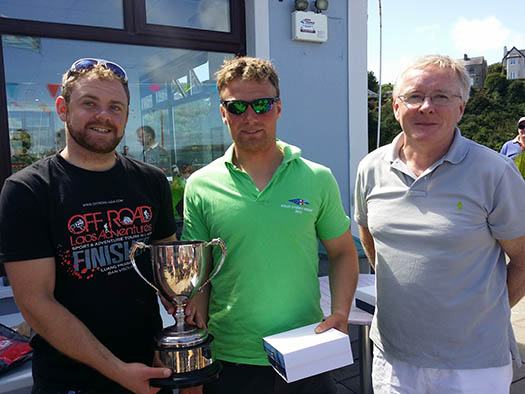
Brian Byrne, Kenneth Rumball
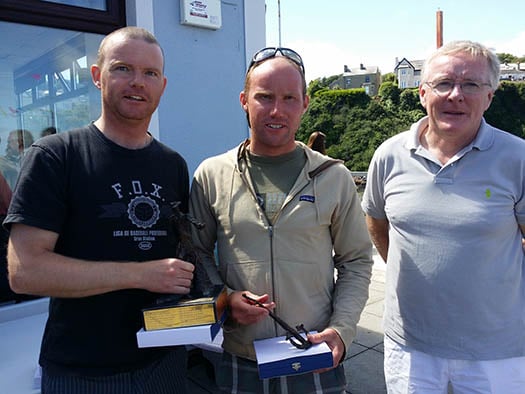
Conor Clancy, James Clancy
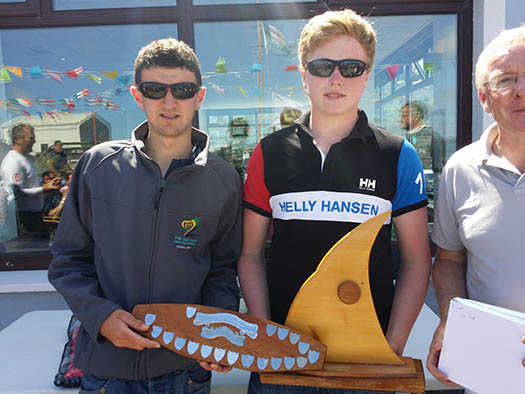
Adrian Lee, Edward Coyne
Mike Murphy, now with son James on board took full advantage of the conditions to record a 4, 3, 3, on Sunday, while Miller & Butler scored two fifths and a fourth.
Colin & Casey's regatta came to a premature end when the hook attaching the kicker to the base of the mast broke and McKenna & O'Keeffe's regatta was cut short by a loose gudgeon on the rudder.
The prize-giving was held in fantastic sunshine on the deck of the clubhouse and due thanks were given to all those who had contributed to a great weekend of racing. The hosting of three classes at a single venue over the same weekend is the only way that these events are viable for clubs. Our current fleet size does allow us to secure a venue by ourselves so we have to partner with other classes if we are to put a calendar together.
Another concern for the Irish Fireball Class must be the low numbers we are experiencing at present. Ten boats is a very poor turnout and means we have to really consider why the numbers are what they are? All events suffer from occasional absences but we no longer have the depth of numbers to accommodate occasional absences when our core fleet is so small.
The club distribution of the Nationals reads as follows:- Royal St George Yacht Club, Dun Laoghaire, 3, Irish National Sailing Club, Dun Laoghaire, 1, Dun Laoghaire Motor Yacht Club, 3, Dun Laoghaire/Clontarf composite, 1, Waterford Harbour Sailing Club (hosts), 1 and Youghal Sailing Club, 1. Of these clubs, three had their full turn-out of known Fireballs at the club, INSC, WHSC and Youghal. Another Dun Laoghaire Fireballer stood at the top of the slipway on the one morning in Dunmore East curious as to why there were so few Fireballs racing.
We don't have an exhaustive calendar with a plethora of events – 5 regattas spread over six months – Open in May, Ulsters in June, Nationals in July, Munsters in September and Leinsters in October. We had a training event in April and the Worlds, organised by others, are in August in Wales.
Of the other clubs where we know there are Fireballs – Skerries (1), Killaloe (4/5), Clontarf (4/5), East Down Yacht Club (2/3) – none were available. On Tuesday of last week, six boats contested the Tuesday race of Dublin Bay Sailing Club and this forthcoming weekend (9th – 12th July), eight Fireballs are registered to contest the Volvo Dun Laoghaire Regatta, even with other Fireball commitments to big boat racing.
The Fireball Worlds take place in Pwllheli, Wales, in the second half of August and it would appear at this stage as if our involvement there will be disproportionately high relative to the size of our domestic fleet size. It is an interesting contrast!
Dunmore East were exceptional hosts again – fresh scones with jam and cream available every morning in the clubhouse, at no charge, an excellent BBQ on the Saturday night and bar staff who kept the drinks flowing until a good hour. Volunteer members cooked and served the meal on Saturday night. Two parties of Fireballers ended up in the same post-mortem venue on the Friday evening – The Spinnaker Bar & Restaurant – before adjourning back to the clubhouse.
Con Murphy espoused punctuality on the race course, starting races on time, turning them around very quickly and starting Fireball races while the "Fifteens" and 420s were still racing.
2015 Irish Fireball Nationals, Waterford Harbour Sailing Club, Overall Results.
1 Barry McCartin & Conor Kinsella 15114 RStGYC 1 1 1 1 1 1 2 1 1 7pts
2 Kenneth Rumball & Brian Byrne 15058 INSC 2 2 3 5 2 2 1 2 2 13pts
3 Conor & James Clancy 15113 RStGYC 3 3 2 2 3 3 3 4 5 19pts
4 Mike Murphy & Alex Voye/James Murphy 14908 WHSC 11 11 4 11 4 4 4 3 3 33pts
5 Mick Creighton & Hugh Johnson 1506X GBC 5 6 7 3 5 5 8 6 6 36pts
The Classic Trophy and the Silver Fleet Prize were won by Edward Coyne and Adrian Lee of Youghal Sailing Club.The regatta prizes and the event overall enjoyed support from sponsors Ernest & Young and the Club Commodore presented the prizes to the three fleets.
For some Irish Fireballers, their next event is across the pond in Wales. For the balance, there is a hiatus until we reconvene at Lough Derg Sailing Club in September for the Munsters. This again will be a shared venue with Wayfarers and 420s.
#RNLI - Dunmore East RNLI is holding a 'blessing of the boats' ceremony and lifeboat open day in Dunmore East harbour next Sunday 21 June at 2pm.
The Dunmore East RNLI all-weather lifeboat will position in the harbour for the ceremony, and all seagoing vessels are welcome to come alongside for the duration.
The flotilla of boats will then head to sea, just outside the harbour wall, where the Dunmore East lifeboat crew will lay a wreath to remember those lost at sea.
At 3pm the Dunmore East Lifeboat will be joined by the Irish Coast Guard helicopter Rescue 117 for a winching demonstration. On return to the harbour, the lifeboat and station house – and lifeboat shop – will be open to the public.
The crew of Dunmore East RNLI are also having a BBQ at the station house afterwards, and welcome everyone to come and join them for a burger and light refreshments complements of the crew, along with music by the Matt Tappers and lots of fun with net mending and splicing competitions open to all.
"The blessing of the boats is a great tradition in Dunmore East and we hope that the fishermen, sailors and all seagoers will join our flotilla to remember those lost at sea," says Dunmore East RNLI's Neville Murphy.
"Our boat will be open to the public, so it a great chance for everyone to get a look inside an all-weather Trent class lifeboat and meet the crew who will answer all your questions.
"Our open day is our way of saying thank you to those who support us in our mission to save lives at sea."
#dunmoreastdredging – The dredging works underway at the entrance to Dunmore East harbour means visitors to the south–east fishery centre will be severely restricted this summer and visitor berths most likely be limited to swinging yacht club moorings. The largely anticipated restriction is due to dredging and is confirmed in a Marine Notice downloadable below. Dredging works are also being carried out in the harbour basin and will be ongoing until September.
Dunmore East Harbour Master Harry McLoughlin says 'Unfortunately, there will be no visiting leisure craft pontoons in place during 2015', McLoughlin suggests calling Waterford Harbour Sailing Club's Cruiser Captain, Rene Wubben on 0872199570 who may be in a position to allocate visitor moorings nearby.


























